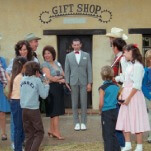Where to start with the music of Fleetwood Mac

Fleetwood Mac 101
It’s impossible to pin down exactly what makes one band obscure and another band one of the biggest-selling attractions in the world. Fleetwood Mac is conspicuously the latter—the group has sold tens of millions of records, and its current stadium tour was recently extended to accommodate the demand of fans, old and new—but it almost didn’t make it. The current and most recognized lineup of Fleetwood Mac is made up of two halves: the original Fleetwood Mac, a British rock band formed in 1967, and the American singing-songwriting duo of Lindsey Buckingham and Stevie Nicks. At the start of 1975, each of those halves had been struggling, completely unknown to each other, for years. Fleetwood Mac had hit the ground running with its deeply bluesy, cult-favorite, self-titled debut in 1968 (also known as Peter Green’s Fleetwood Mac, both in honor of the group’s founding singer-guitarist and to differentiate it from the group’s eponymous, 1975 breakthrough album), but it had floundered in a perpetual turnover of frontmen; Buckingham and Nicks had released one self-titled full-length under the name Buckingham Nicks in 1973, a gorgeous work of understated, California folk-pop that failed to find any traction with the public at large. Some of the tracks from Buckingham Nicks, most notably “Crystal,” would later be performed with Fleetwood Mac to much greater acclaim.
Something inexplicable happened when Fleetwood Mac and Buckingham Nicks joined forces for 1975’s Fleetwood Mac. The merger was spurred as much by desperation as anything else, but that Hail Mary resulted in a victory. Buckingham’s lithe, chiming guitar owed an equal debt to the jangle of The Byrds’ Roger McGuinn and the elegant intricacy of jazz legend Django Reinhardt, both of which were heroes of Buckingham. Nicks’ husky, otherworldly voice was the perfect complement. But Fleetwood Mac brought Buckingham and Nicks what they lacked: The subtle muscularity of a rhythm section provided by drummer Mick Fleetwood and bassist John McVie, and the ethereality of singer-keyboardist Christine McVie. Fleetwood Mac also had the readymade recipe for tension: Two romantic couples formed most of the group, a dynamic that sparked more friction when Fleetwood Mac slowly but surely rose to the top of the charts on the back of hits like the brooding “Rhiannon” and the bouncy “Say You Love Me,” not to mention the introspectively anthemic “Landslide.” The crush of success put an instant strain on a group of twentysomethings—still getting to know each other, and flush with overnight wealth plus all the temptations that come with it—and that pressure would perversely fuel their imminent masterpiece.
Rumours was that masterpiece. Released in 1977, the 10th anniversary of Fleetwood Mac’s founding, it became monstrously successful. While the band’s closest contemporary, The Eagles, were riding high on the success of their biggest album, Hotel California, Rumours spun a similarly moody, weary, West Coast vibe into something far more timeless. Alternating between the fragility of “Dreams” and the acidity of “Go Your Own Way”—and between the hopeful swagger of “Don’t Stop” and the dreamy funkiness of “You Make Loving Fun”—the album harnessed the band’s internal emotional combustion in a way that felt effortlessly catchy. Artists as recent, and as different, as Midlake and Haim have demonstrated just how durable the influence of Rumours has remained, even after being played to the point of becoming aural wallpaper over the decades. It’s the epitome for the multiplatinum pop album, but it’s also serious, with dark depths abound and an elaborate, painstaking production that reflects Buckingham’s increasing obsession with another hero of his, The Beach Boys’ Brian Wilson, at the time. And like The Beach Boys’ Pet Sounds, Rumours is a once-in-a-career pop phenomenon: an intensely personal vision that ultimately resonates because of its idiosyncrasy, rather than in spite of it.
Intermediate Work
Buckingham’s obsession with Wilson-esque lushness—not to mention the nervier influences of punk rock and drugs—didn’t bode as well, commercially speaking, for Tusk. Fleetwood Mac’s first album since Rumours, it was released in 1979 and, understandably, was one of the most anticipated albums in history up to that time. For fans as well as the music industry, it didn’t live up to Rumours, although hindsight has redeemed it. It didn’t exactly flop. It still sold in the millions, although far less than Fleetwood Mac or Rumours. But the exorbitant cost of Buckingham’s manic production sessions—plus the double-album format—made it problematic when it came to profitability, and that put extra strain on a group that suddenly found itself on a pedestal as one of the most popular acts of all time. That ambitious sprawl also made it a challenge for radio programmers as well as listeners, especially after the smoothness of Rumours. Tusk’s redemption is in its songs; while the whole feels fragmented, the parts are stunningly adventurous, from the rambling Nicks’ tone-poem “Sara” to Buckingham’s stark, country-punk oddity “The Ledge.”








































